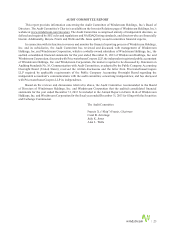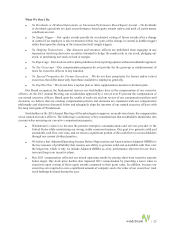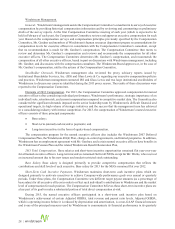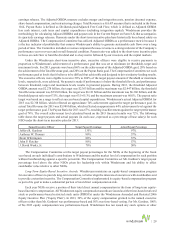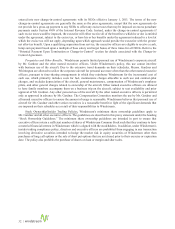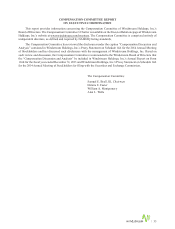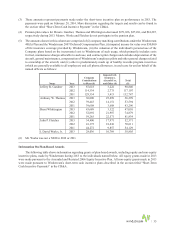Windstream 2013 Annual Report Download - page 37
Download and view the complete annual report
Please find page 37 of the 2013 Windstream annual report below. You can navigate through the pages in the report by either clicking on the pages listed below, or by using the keyword search tool below to find specific information within the annual report.
| 31
the three fiscal performance periods covered by the vesting schedule. The Total Stockholder Return goal is measured
by comparing Windstream total stockholder return against the cumulative total return of the S&P 500 index. The
Compensation Committee chose the broader S&P 500 index over the S&P telecom index because the telecom index
is comprised of only eight (8) companies, including AT&T and Verizon, which are not impacted by the same issues
and environment given their larger size and their focus on wireless businesses. Pursuant to the Overachievement
Measure, an additional 25% of shares will be issued if Windstream total stockholder return is between the 50-75th
percentile of the S&P 500 and an additional 50% of shares will be issued for performance over the 75th percentile.
Severance Benefits and Gardner Employment Agreement. Except for Messrs. Gardner and Works, Windstream
has no agreement or plan to provide severance benefits to executive officers other than benefits that are generally
available to all employees under Windstream’s severance plan and benefits available under the change-in-control
agreements discussed below. The employment agreement with Mr. Gardner includes a severance benefit of three
times base salary (at the time of severance), or $3.0 million based on Mr. Gardner’s base salary during 2013. The
employment agreement provides for no gross up of taxes for severance outside of a change-in-control situation.
The employment agreement provides that Mr. Gardner’s base salary will be no less than $700,000 per year. If Mr.
Gardner experiences a separation from service following a change of control, the severance benefits provided under
the terms of the change-in-control agreements discussed below will govern, and no severance is available under
the employment agreement in such circumstance. The Compensation Committee approved the foregoing severance
benefit to Mr. Gardner to recognize the importance of his service and contributions to Windstream, to recognize that
it would be difficult for him to find comparable employment during a short period of time following a separation,
and to reflect market practice of providing similar severance benefits to the CEO position. As part of his offer letter
with Windstream, Mr. Works is eligible to receive severance benefits of one times his salary and target bonus if
his employment is terminated by Windstream for any reason other than cause or for resignation for good reason
(as defined in his change in control agreement) prior to February 1, 2017, which is the five-year anniversary of his
employment with Windstream.
Retirement Plans. Windstream maintains a defined benefit pension plan and a qualified 401(k) defined
contribution plan for its executive officers (including the NEOs) and employees. Participation in the pension plan
is frozen except for certain bargaining unit employees. No executive officer is eligible for continued accruals.
Windstream’s 401(k) plan provides for potential matching employer contributions of up to 4% of a participant’s
compensation. The Compensation Committee maintains the 401(k) plan in order to provide employees with
an opportunity to save for retirement with pre-tax dollars. The 401(k) plan also allows Windstream to fund its
contributions to this plan in a predictable, consistent manner.
Deferred Compensation Plans. Windstream’s 2007 Deferred Compensation Plan provides a non-qualified
deferred compensation plan for its executive officers (including the NEOs) and other key employees. The
Compensation Committee adopted this plan as part of its effort to provide a total compensation package that was
competitive with the compensation arrangements of other companies. The plan offers participants the ability to defer
compensation above the IRS qualified plan limits.
Change-In-Control Agreements. The Compensation Committee maintains change-in-control agreements for
Mr. Gardner and each executive officer (including the NEOs) in order to provide some protection to those individuals
from the risk and uncertainty associated with a potential change-in-control. The Compensation Committee also
maintains the change-in-control agreements as part of its efforts to provide a total compensation package that is
competitive with the compensation arrangements of other market participants.
The change-in-control agreements in place during 2012 expired on January 1, 2013. The Compensation
Committee specifically engaged PM&P to review the payment multiples and other terms of the change-in-control
agreements, to compare such provisions against prevailing market practices, and to provide recommendations on the
final terms of the agreements. When it approved the change-in-control agreements, the Compensation Committee
considered the total amount of compensation that Mr. Gardner and each other executive officer would receive in
a hypothetical termination under all of the change-in-control benefits described below. Based on the foregoing,
the Compensation Committee approved the payment of change-in-control benefits to Mr. Gardner and the other
executive officers on a “double-trigger” basis, which means that a change-in-control of Windstream must occur and
the officer’s employment with Windstream must be terminated through either a resignation for “good reason” or a
termination without “cause” (as those terms are defined in the change-in-control agreement). As a result, Windstream




